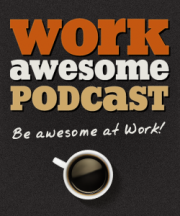David Allen is known as the GTD Guy. Stever Robbins is known as the GID Guy. Both offer great insights on productivity using very different approaches. Both are also published authors, and Robbins’ latest book, Get-It-Done Guy’s 9 Steps to Work Less and Do More, hit bookstores a few weeks back. The book is a fairly light read, yet brimming with tips and information that are sprinkled with Robbins’ signature humor and style.
In Get-It-Done Guy’s 9 Steps to Work Less and Do More, Robbins offers a step-by-step method that appears less daunting than the popular methodology than David Allen’s GTD methodology. I wouldn’t necessarily say it is less daunting once you dive in, but it is an approach that might be easier to adopt for some. It’s more of a “grassroots” approach to becoming more productive. Robbins breaks how you can work less and do more into the following steps:
- Live on purpose
- Stop procrastinating
- Conquer technology
- Beat distractions to cultivate focus
- Stay organized
- Stop wasting time
- Optimize
- Build stronger relationships
- Leverage
These steps (which are broken into individual chapters) are fairly self-explanatory on the surface, but once you dig into them it’s easy to see that without working on each consistently then you will quickly go off course. One of the ideas Robbins presents in the book is the use of a Life Map, which helps you keep tabs on what’s important. He outlines how he does this in the following excerpt from the book:
On Reviewing Life Goals and Priorities
Here are some of my favorite times to review my Life Map to bring me back on track:
- When surfing the web, reading email, or doing anything online. Commenting on a blog about celebrity acne can wait. At least, I’m pretty sure it can.
- Before running errands. Do I really need new boxer briefs right now? Maybe I’ll just do laundry, instead.
- Making outbound phone calls. Aunt Sally will still be there tonight. Maybe I can call her then, and make progress on my life during the day today.
- Doing administrative stuff. Filing bills makes me feel so organized! I just love filing! But administrative tasks rarely make progress on my most important goals. We’ll learn how to deal with administrivia elsewhere in the book. Your life map will get you back on path if now isn’t the best time to address envelopes.
Robbins has a light touch with his words, bringing a dash of accessible humor to the book and does so without compromising the message. It’s not a “jokey” book, it’s a book that delivers a message in a way that keeps the reader engaged with a topic that can become very dry very quickly. The excerpt below demonstrates just how Robbins is able to balance information and wit in his writing:
On Setting Boundaries to Prevent Interruptions:
If you spend all your time supporting your co-workers, you’ll never get your own work done. If your boss is who interrupts you the most sit down and say, “interruptions break my flow enough that they really tank my productivity for the hour. Would you rather I be immediately responsive to your IMs, or would you rather I work in the Zone and check my inboxes a few times a day at defined times?” If your boss isn’t mature enough to hear that, then he/she does not understand his/her job and you should expect them to be promoted to executive sometime in the next six months. If your boss is competent, however, it should lead to much improved working conditions during your boss’s remaining three weeks at the company.
Robbins has been on the productivity scene for a while, so he has the credentials to back up his words. He hosts a very popular podcast, takes the time out of his busy schedule to oversee frequently scheduled Action Days and is consistent with his message — and with how he delivers it. This book is the most accessible book I’ve read on the subject of personal productivity. It’s ideal for the individual who knows they need to be more productive but is using the excuse that they find self-development books tedious.
In another short except, Robbins offers his thoughts on the paper/technology productivity debate. While he loves gadgets and shiny things, he seems to reside in the camp that paper is a better tool to get stuff done:
On Technology’s Promise of Getting Things Done:
If anything, technology has helped us work more and do less . Technology certainly changes how we do things, but it often makes less work in one area while making much more work in others. And it’s expensive, requiring more work to pay for the cool technology that helps us work less.
Get-It-Done Guy’s 9 Steps to Work Less and Do Moreis the perfect holiday gift for someone looking to make productivity a priority and need a straightforward book to get them on their way.







This is an awesome article. I agree with the sentiments above, though I have to say most likely only higher up companies will make people feel that way. I’m betting 90% of jobs won’t. 🙂
Really worth a shot and will read the book when i get a copy from somewhere …..
Thanks for great advise ….
Get-It-Done Guy’s 9 Steps to Work Less and Do More is the perfect holiday gift for someone looking to make productivity a priority and need a straightforward book to get them on their way.
The link is broken.
Thanks – link has been fixed!
Just found his podcast – and HIGHLY recommend it.
Each segment is really short (5-6mins) – but awesome info.
thanks for sharing!
“Get-It-Done Guy’s 9 Steps to Work Less and Do More” looks like a great book to get and have it at hand for quick reference. I’ve been listening to some of the podcast and besides being funny they contain wealth of practical information that you can straight away.
I’ve added this book to my wish list and look forward to read it.
I love this post.
One of the reasons for the lack of productivity is also not being with all our senses in what we do, we are more effective if we are concentrate.